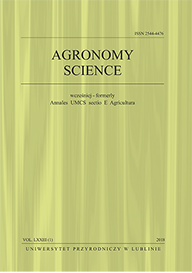Productivity of winter wheat Turnia and Rysa cultivars sown in pure and mixed stand depending on tillage systems
ANDRZEJ LEPIARCZYK
Katedra Agrotechniki i Ekologii Rolniczej, Uniwersytet Rolniczy im. H. Kołłątaja w Krakowie al. Mickiewicza 21, 31-120 KrakówTEOFIL ŁABZA
Katedra Agrotechniki i Ekologii Rolniczej, Uniwersytet Rolniczy im. H. Kołłątaja w Krakowie al. Mickiewicza 21, 31-120 KrakówKATARZYNA PUŻYŃSKA
Katedra Agrotechniki i Ekologii Rolniczej, Uniwersytet Rolniczy im. H. Kołłątaja w Krakowie al. Mickiewicza 21, 31-120 KrakówAbstract
The aim of the study was to analyze productivity given in dry matter energy and protein yield, of two winter wheat cultivars, sown in pure and mixed stands on ploughing and plougless soil tillage systems. The research was carried out in strict crop rotation experiment, established at the Experimental Station Kraków-Mydlniki, belonging to the Department of Agrotechnology and Agricultural Ecology, University of Agriculture in Kraków. The experiment was conducted in 2006–2008 by randomized blocs in four replications. The previous crop of winter wheat was faba bean. The first of the two tested factors was soil tillage systems (ploughing – conventional and ploughles – reduced) while the second – wheat cultivar (Turnia and Rysa) sown in pure or mixed (1:1 ratio) stand. The assessment of crop cultivars productivity was based on the grain yield, total protein and energy value, assuming that 1 kg d. m. = 18.41 MJ. A significant difference of cultivars productivity expressed as dry matter, protein and energy yield depending on tillage system was obtained.
Keywords:
productivity, winter wheat, cultivar, soil tillage systemsReferences
Carr P.M., Horsley R.D. Poland W.W., 2003. Tillage and seeding rate effects on wheat cultivars I. Grain production. Crop Sci. 43 (1), 202–209.
Chatskikh D., Olesen J.E., Hansen E.M., Elsgaard L., Petersen B.M., 2008. Effects of reduced tillage on net greenhouse gas fluxes from loamy sand soil under winter crops in Denmark. Agric. Ecosyst. Environ. 128, 117–126.
Ciha A.J., 1982. Yield and yield components of four spring wheat cultivars grown under three tillage systems. Agron J. 74 (2) 317–320.
Dzieżyc J., Nowak L., Panek K., 1987. Dekadowe wskaźniki potrzeb opadowych roślin uprawnych w Polsce. Zesz. Probl. Post. Nauk Rol. 314, 11–13.
Janosky J. S., Young D. L., Schillinger W. F., 2002. Economics of conservation tillage in a wheat–fallow rotation. Agron. J. 94, 527–531.
Jarrige R., 1993. Żywienie przeżuwaczy. Zalecane normy i tabele wartości pokarmowej pasz. IFiŻZ PAN, Jabłonna.
Kordas L., 1999. Energochłonność i efektywność różnych systemów uprawy roli w zmianowaniu. Folia Univ. Agric. Stein., Agricultura 74, 47–52.
Kordas L., 2005. Energy and economic effects of reduced tillage in crop rotation. Acta Sci. Pol., Agricultura 4(1), 51–59.
Krasowicz S., Stuczyński T., Doroszewski A., 2009. Produkcja roślinna w Polsce na tle warunków przyrodniczych i ekonomiczno-organizacyjnych. [W:] Kierunki zmian w produkcji roślinnej w Polsce do roku 2020. Studia i Raporty IUNG – PIB Puławy, 14, 27–54.
Kulig B., Lepiarczyk A., Oleksy A., Kołodziejczyk M., 2010. The effect of tillage system and forecrop on the yield and values of LAI and SPAD indices of spring wheat. Eur. J. Agron., 33 (1), 43–51.
Lafond G.P., May W.E., Stevenson F.C., Derksen D.A., 2006. Effects of tillage systems and rotations on crop production for a thin Black Chernozem in the Canadian Prairies. Soil Till. Res. 89, 232–245.
Lithourgidis A.S., Dhima K.V., Damalas C.A., Vasilakoglou I.B., Eleftherohorinos I.G., 2008. Tillage effects on wheat emergence and yield at varying seeding rates, and on labor and fuel consumption. Crop Sci. 46, 1187–1192.
Loyce C., Meynard J.M., Bouchard C., Rolland B., Lonnet P., Bataillon P., Bernicot M.H., Bonnefoy M., Charrier X., Debote B., Demarquet T., Duperrier B., Félix I., Heddadj D., Leblanc O., Leleu M., Mangin P., Méausoone M., Doussinault G., 2008. Interaction between cultivar and crop management effects on winter wheat diseases, lodging, and yield. Crop Protect. 27, 1131–1142.
Małecka I., 2006. Produktywność roślin w płodozmianie w zależności od systemów uprawy roli. Fragm. Agron. 23(2), 261–272.
Nail E.L., Young D.L., Schillinger W.F., 2007. Diesel and glyphosate price changes benefit the economics of conservation tillage versus traditional tillage. Soil Till. Res. 94, 321–327.
Ozpinar S., Cay A., 2006. Effect of different tillage systems on the quality and crop productivity of a clay–loam soil in semi-arid north-western Turkey. Soil Till. Res. 88, 95–106.
Rieger S., Richner W., Streit B., Frossard E., Liedgens M., 2008. Growth, yield, and yield components of winter wheat and the effects of tillage intensity, preceding crops, and N fertilisation. Eur. J. Agron. 28, 405–411.
Sánchez-Girón V., Serrano A., Suárez M., Hernanz J.L., Navarrete L., 2007. Economics of reduced tillage for cereal and legume production on rainfed farm enterprises of different sizes in semiarid conditions. Soil Till. Res. 95, 149–160.
Schillinger W.F., Young D.L., 2004. Cropping systems research in the world's driest rainfed wheat region. Agron. J. 96, 1182–1187.
Singh B., Malhi S.S., 2006. Response of soil physical properties to tillage and residue management on two soils in a cool temperate environment. Soil Till. Res. 85, 143–153.
Šíp V., Růžek P., Chrpová J., Vavera R., Kus H., 2009.The effect of tillage practice, input level and environment on the grain yield of winter wheat in the Czech Republic. Field Crops Res., 113 (2), 131–137.
Tebrügge F., Düring R.A., 1999. Reducing tillage intensity – a review of results from a long-term study in Germany. Soil Till. Res. 53, 15–28.
Uri N.D., 2000. An evaluation of the economic benefits and costs of conservation tillage. Environ. Geol. 39 (3–4), 238–248.
Verch G., Kächele H., Höltl K., Richter C., Fuchs C., 2009. Comparing the profitability of tillage methods in Northeast Germany a field trial from 2002 to 2005. Soil Till. Res. 104, 16–21.
Weber R., Biskupski A., 2008. Wpływ gęstości i terminu siewu na plonowanie kilku odmian pszenicy ozimej w warunkach bezpłużnej uprawy roli. Annales UMCS, sec. E, 63, 1, 17–24.
Weber R., Hryńczuk B., 2004. Wpływ uproszczeń w uprawie roli na zmienność plonowania i komponentów plonu kilku odmian pszenicy ozimej. Annales UMCS, sec. E, 59, 1, 501–508.
Weber R., Podolska G., 2008. Wpływ sposobu uprawy roli, terminu i gęstości siewu na plonowanie odmian pszenicy ozimej. Inż. Roln. 1(99), 395–400.
Weber R., Zalewski D., 2005. Plonowanie odmian pszenicy ozimej w warunkach Dolnego Śląska. Annales UMCS, sec. E, 60, 59–70.
Zamani A.S., Nasseri A., 2007. Tillage method and seed rate effects on dryland winter wheat. Asian J. Plant Sci. 6(5), 864–868.
Katedra Agrotechniki i Ekologii Rolniczej, Uniwersytet Rolniczy im. H. Kołłątaja w Krakowie al. Mickiewicza 21, 31-120 Kraków
Katedra Agrotechniki i Ekologii Rolniczej, Uniwersytet Rolniczy im. H. Kołłątaja w Krakowie al. Mickiewicza 21, 31-120 Kraków
Katedra Agrotechniki i Ekologii Rolniczej, Uniwersytet Rolniczy im. H. Kołłątaja w Krakowie al. Mickiewicza 21, 31-120 Kraków
License
Articles are made available under the conditions CC BY 4.0 (until 2020 under the conditions CC BY-NC-ND 4.0).
Submission of the paper implies that it has not been published previously, that it is not under consideration for publication elsewhere.
The author signs a statement of the originality of the work, the contribution of individuals, and source of funding.
Self-Archiving Policy
Agronomy Science has adopted a self-archiving policy called blue by the Sherpa Romeo database. From 2021 authors can self-archive article postprints and editorial versions (under the CC BY 4.0 licence). Articles from earlier years (available under the CC BY-NC-ND 4.0 licence) can only be self-archived as editorial versions.




